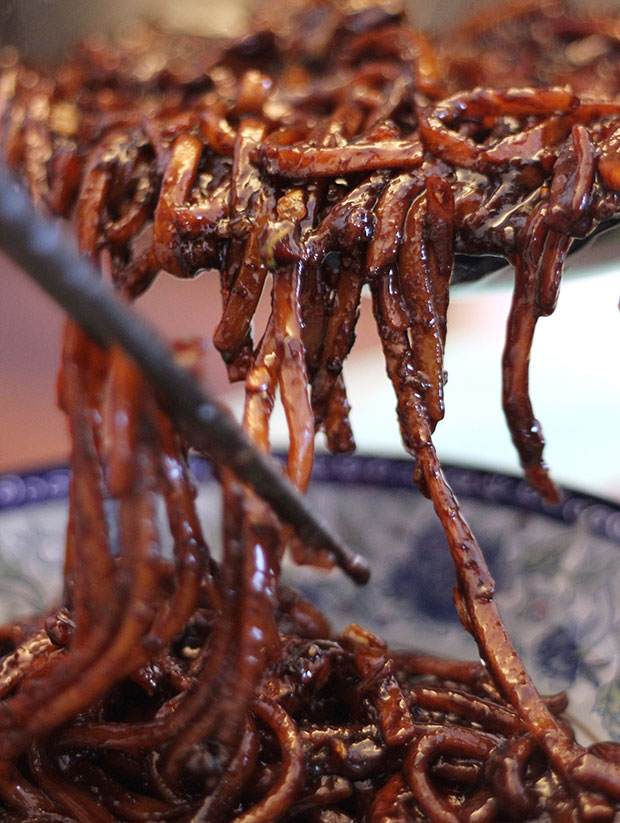KUALA LUMPUR, Aug 6 — Oh, Hokkien mee! How do I love thee? Let me count the ways.
But before I start listing the evidence testifying my love for this divine noodle dish, let me first clarify what I mean by Hokkien mee. For you see, depending on which part of the peninsula you’re at, Hokkien mee can mean a very different dish to different people.
For my friends in Penang and Ipoh, Hokkien mee is characterised by its spicy broth made with prawn heads and shells. Sliced prawns are the main “meat” of the dish, together with sliced pork and sometimes fish balls. Some fibre thanks to leafy kangkung and crunchy bean sprouts. Fragrant nuggets of pork lard and fiery sambal complete this soupy dish.
This isn’t the Hokkien mee I mean.

For my friends further south, all the way in Singapore, Hokkien mee is a stir-fried noodle dish, flavoured with prawn broth but not soupy like its Penang namesake. Again, prawns, fish balls and some leafy greens are a reoccurring motif. Sambal, too. But my healthy-conscious Singaporean friends have substituted chicken lard for pork lard.
This isn’t the Hokkien mee I mean either.
The Hokkien mee that I love “the depth and breadth and height/my soul can reach, when feeling out of sight” (with apologies to Elizabeth Barrett Browning) is the Kuala Lumpur or KL variety. Dark, glossy, slick with sauce the colour of a sinful soul, these noodles are what I (and many a pub crawler and club-goer) crave in the midnight hours.

It has the right colour, for one, and all the grease you may desire when decent folks are long in bed, dreaming sweetly. While the Penang and Singapore versions use egg noodles or rice vermicelli, the Hokkien mee I love uses thick, fat yellow noodles known — no surprise here — as Hokkien noodles.
The northern and southern varieties are untouched by even a single lick of dark soy sauce; the KL version is properly drowning in the stuff.
And the pork lard, crunchy and greasy and oh so sinful. And the indispensable touch of wok hei — the “breath of the wok” — that imparts the charcoal-fuelled aroma. And... I could go on for hours counting the ways but I rather just enjoy a plate of Hokkien mee I so adore!
KL-STYLE HOKKIEN MEE
For me, there are two essential ingredients to an authentic KL-style Hokkien mee. The first is obvious: crisp cubes of fried pork lard that gives the dish much of its aroma. (The oil rendered from frying the pork lard is used for frying the noodles too, which gives the dish a double dose of lardy goodness.)
A lesser known ingredient so key to the Hokkien mee’s special taste is the dried flounder or dadi yu in Chinese. It’s actually the dehydrated powder form of the flounder, a saltwater flatfish. More commonly used in preparing Chinese soups, the dried flounder powder adds a hit of umami that’s barely there but noticeable when missing.

If there is an invisible third element to a great Hokkien mee, it is the wok hei. This depends in equal parts on skill (or experience) in wielding the wok and a roaring fire (preferably charcoal fire, purists will tell you, but that’s not really practical for most of us cooking at home).
No plate of Hokkien mee would be complete without something spicy to enjoy it with. Most Hokkien mee enthusiasts favour a thick sambal paste as a condiment to the noodles but I personally prefer Chiu Chow (Teochew) chilli oil. Both can be fiery so dip away with caution.
Ingredients
500g Hokkien noodles
1 tablespoon corn starch
2 tablespoons water
50g pork lard, cubed
2 tablespoons of cooking oil
8 cloves of garlic, minced
150g shrimp, peeled and deveined
150g of pork, sliced thinly
1 Chinese cabbage, coarsely chopped
2 tablespoons oyster sauce
6 tablespoons dark soy sauce
3 tablespoons light soy sauce
1 teaspoon sesame oil
250ml of chicken stock
1 teaspoon dried flounder (dadi yu) powder
White pepper to taste
Chiu Chow chilli oil, for dipping
Method
First prepare the Hokkien noodles by blanching them with boiling water. Drain thoroughly when the noodle strands have separated. Set aside. In a small bowl, mix the corn starch and water together till well-combined. Set aside for use at the end of cooking.
Heat a wok or large pan over medium heat. Add the cubed pork lard and cooking oil. Allow the fat to render slowly while you watch the fire to prevent the lard cubes from burning. Once the lard cubes are light golden-brown, remove from the oil and set aside.

Leave the mix of rendered fat and cooking oil in the wok. Increase the heat to high (for the wok hei) and add the minced garlic. Sauté till aromatic (less than a minute), then add the shrimp and sliced pork. Fry these till almost fully cooked. Add the Chinese cabbage and fry till the leaves have wilted slightly.
At this point, add the Hokkien noodles and the sauces (oyster sauce, dark soy sauce, light soy sauce and sesame oil). Toss everything together thoroughly to ensure all the ingredients are well-coated with the gravy.
Add the chicken stock, half of the fried lard cubes, the dried flounder (dadi yu) powder and white pepper to taste. Stir everything together and reduce the heat slightly to allow the gravy to thicken. Add some of the corn starch mixture to thicken the gravy further. If there is still too much liquid, add more corn starch mixture to continue thickening the gravy.
Once the gravy has sufficiently thickened, ladle the noodles onto a large plate or platter. Serve immediately with the rest of the fried lard cubes and Chiu Chow chilli oil on the side.
For more Weekend Kitchen stories and recipes, visit http://devilstales.com/weekend-kitchen/






















